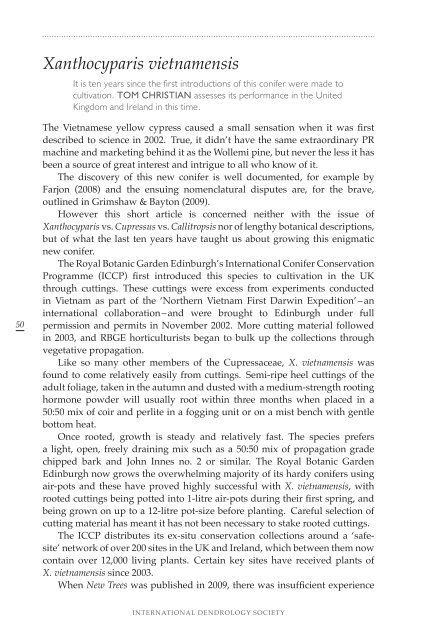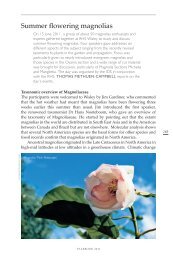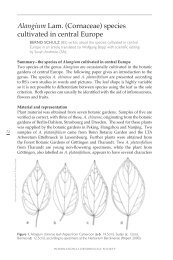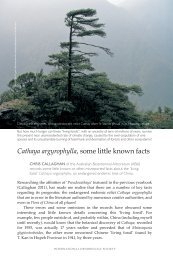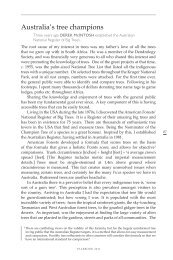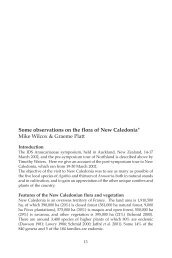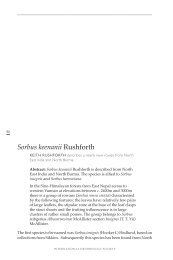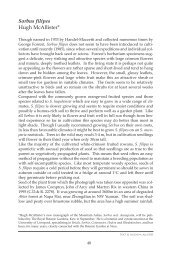Xanthocyparis vietnamensis - International Dendrology Society
Xanthocyparis vietnamensis - International Dendrology Society
Xanthocyparis vietnamensis - International Dendrology Society
You also want an ePaper? Increase the reach of your titles
YUMPU automatically turns print PDFs into web optimized ePapers that Google loves.
<strong>Xanthocyparis</strong> <strong>vietnamensis</strong>It is ten years since the first introductions of this conifer were made tocultivation. TOM CHRISTIAN assesses its performance in the UnitedKingdom and Ireland in this time.50The Vietnamese yellow cypress caused a small sensation when it was firstdescribed to science in 2002. True, it didn’t have the same extraordinary PRmachine and marketing behind it as the Wollemi pine, but never the less it hasbeen a source of great interest and intrigue to all who know of it.The discovery of this new conifer is well documented, for example byFarjon (2008) and the ensuing nomenclatural disputes are, for the brave,outlined in Grimshaw & Bayton (2009).However this short article is concerned neither with the issue of<strong>Xanthocyparis</strong> vs. Cupressus vs. Callitropsis nor of lengthy botanical descriptions,but of what the last ten years have taught us about growing this enigmaticnew conifer.The Royal Botanic Garden Edinburgh’s <strong>International</strong> Conifer ConservationProgramme (ICCP) first introduced this species to cultivation in the UKthrough cuttings. These cuttings were excess from experiments conductedin Vietnam as part of the ‘Northern Vietnam First Darwin Expedition’ – aninternational collaboration – and were brought to Edinburgh under fullpermission and permits in November 2002. More cutting material followedin 2003, and RBGE horticulturists began to bulk up the collections throughvegetative propagation.Like so many other members of the Cupressaceae, X. <strong>vietnamensis</strong> wasfound to come relatively easily from cuttings. Semi-ripe heel cuttings of theadult foliage, taken in the autumn and dusted with a medium-strength rootinghormone powder will usually root within three months when placed in a50:50 mix of coir and perlite in a fogging unit or on a mist bench with gentlebottom heat.Once rooted, growth is steady and relatively fast. The species prefersa light, open, freely draining mix such as a 50:50 mix of propagation gradechipped bark and John Innes no. 2 or similar. The Royal Botanic GardenEdinburgh now grows the overwhelming majority of its hardy conifers usingair-pots and these have proved highly successful with X. <strong>vietnamensis</strong>, withrooted cuttings being potted into 1-litre air-pots during their first spring, andbeing grown on up to a 12-litre pot-size before planting. Careful selection ofcutting material has meant it has not been necessary to stake rooted cuttings.The ICCP distributes its ex-situ conservation collections around a ‘safesite’network of over 200 sites in the UK and Ireland, which between them nowcontain over 12,000 living plants. Certain key sites have received plants ofX. <strong>vietnamensis</strong> since 2003.When New Trees was published in 2009, there was insufficient experienceINTERNATIONAL DENDROLOGY SOCIETY
TREESphotograph © Seamus O’BrienOne of the best plants of<strong>Xanthocyparis</strong> <strong>vietnamensis</strong>in cultivation at KilmacurraghBotanic Garden in CountyWicklow (Ireland).51of this new conifer to allow the authors to muse too much over its merit incultivation, saying as they did “When seen in the greenhouses in Edinburgh in2005…they have grown well, but it is not yet known whether this species willbe hardy in our area” (Grimshaw & Bayton 2009).One of the first sites in the ICCP network to receive material was BedgeburyNational Pinetum, Kent. Bedgebury took an experimental approach withtheir plants, planting them in different areas of the collection to ‘test thewater’ though always in relatively sheltered situations. The cold winters thatBedgebury experiences provided one of the first tangible indications of thehardiness of X .<strong>vietnamensis</strong>, especially the extraordinary winters of 2008 - 2009and 2009 - 2010 when temperatures in the pinetum were recorded as low as-14 °C. All of the young plants came through unscathed.In the same winter, a plant much further north at Cluny House Gardens,Perthshire, was growing in moist but well drained, humus rich soils onrelatively flat ground. Temperatures remained below 0 °C for over two weekshere, and it was on the coldest of these days when the temperature fell to -18 °CYEARBOOK 2012
XANTHOCYPARIS VIETNAMENSIS52photographs © Tom ChristianA healthy plant of <strong>Xanthocyparis</strong> <strong>vietnamensis</strong> inthe woodland garden at RBG Edinburgh.A plant of <strong>Xanthocyparis</strong> <strong>vietnamensis</strong> scorchedby exposure to cold winds at RBG Edinburgh.that the Cluny plant of X. <strong>vietnamensis</strong>finally gave up, turning crisp andbrown almost overnight.Other victims of the same winterincluded a plant at Dundonnell, WesterRoss, surely up to that point the mostnortherly in the UK and Ireland. Theplant at Dundonnell had been plantedin a relatively damp position, whichwas very likely a contributing factorin its demise as temperatures dipped‘only’ as low as -15 °C.Two plants at the Royal BotanicGarden Edinburgh survived thewinters. One came through relativelyunscathed, enjoying the conditions ofthe upper woodland garden, wherea canopy of mature trees and theproximity of large shrubs providedshelter. The plant on the other sideof the garden was not so fortunate,planted a little to the north of the JohnHope Gateway on the western edgeof the garden it was exposed to strongwesterly winter winds which took asevere toll on the plant. Althoughit survived it never really recoveredand eventually had to be removed.Other survivors include plants atLogan Botanic Garden which enjoysthe full benefits of the Gulf Stream onScotland’s south-westernmost tip.A plant at Murthly Castle, Perthshire,planted in spring 2011 in moistbut well drained, riparian soils inmixed woodland has put on a steady15 cm of growth in height per yearso far, having come through tworelatively mild winters.Perhaps unsurprisingly for aspecies from northern Vietnam, thevery best growth rates the ICCP hasso far observed have been on plantsINTERNATIONAL DENDROLOGY SOCIETY
XANTHOCYPARIS VIETNAMENSIS54success is a look at Alan Mitchell’s list of notable specimens (Mitchell, 1975)and consideration of how different such a list would now look following theextensive distribution of Taiwania in the last 20 years by ICCP and others, astouched on by Grimshaw (2011).What such a list for X. <strong>vietnamensis</strong> would look like in 20, 50 or 100 yearstime remains to be seen. Besides the aforementioned sites to which the ICCPdistributed plants early on, additional material has since been distributedto the National Botanic Gardens at Glasnevin in Dublin, the University ofDurham Botanic Garden, the Eden Project, Batsford Arboretum, RHS Wisleyand Wakehurst Place.The realities of modern plant collecting and introduction, most particularlythe CBD, would suggest that X. <strong>vietnamensis</strong> is likely to remain quite a rarityfor some time to come – (legally) available only through affiliation withinstitutions who have obtained the legal permission to collect and exportmaterial from its natural range.Most recently, an introduction was made by a team from the ForestryCommission’s Westonbirt Arboretum working in conjunction with Vietnamesepartners. The seed was sent to Forest Research at Alice Holt where it wasx-rayed. Although only a small proportion of seed was found to be healthy,these were sent to Bedgebury Pinetum and sown in April 2011. To everyone’sgreat delight, the first germination took place in October 2011, and Bedgeburyare now bringing on several young seedlings.These seedlings are a significant step in the story of the cultivation ofX. <strong>vietnamensis</strong>. It is the first time the species has been grown from seed,and it raises the possibility that further seed collections will be successful inthe future. If so, this will greatly increase the genetic diversity of plants incultivation, helping to bolster the value of conservation collections held in UKand Irish gardens.The size and stature that individuals in the UK and Ireland might takeon in the future is, at the moment, anybody’s guess. In the wild plants arerelatively small, just a few metres tall and often contorted due to their habitatatop limestone carst mountains, exposed to the elements.Perhaps X. <strong>vietnamensis</strong> will make a handsome, small-medium sized tree incultivation, similar in size and stature to Thuja koraiensis? This of course is pureconjecture, only time will tell, and waiting to see will be half the fun!ReferencesFarjon, A. (2008) A Natural History of Conifers. Timber Press, USA.Grimshaw, J & Bayton, R. (2009) New Trees – Recent Introductions to Cultivation. RoyalBotanic Gardens, Kew, UK.Grimshaw, J. (2011) Tree of the Year: Taiwania Cryptomerioides, IDS Yearbook 2010, pp. 25-57.Mitchell, A. F. (1975) Conifers in the British Isles [second impression]. Her Majesty’s StationaryOffice, London.INTERNATIONAL DENDROLOGY SOCIETY


